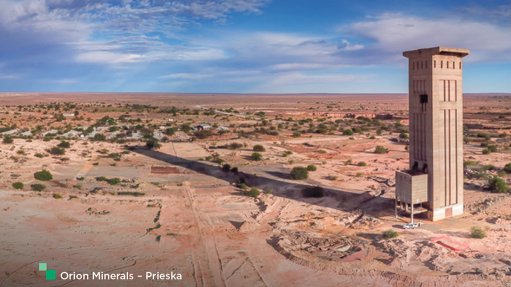
Preiska
Copper mine developer Orion Minerals has benefitted from significant investor patience to fulfil its redevelopment of two significant and historic mining hubs, owing to the difficulty in securing project development funding over several years.
Nonetheless, Orion has managed to assemble a range of key investors, supporters and financiers that collectively will help fulfil the company’s production ambitions, according to a resource bulletin issued by mining analyst Mine Life director Gavin Wendt on July 22.
Earlier this month, Orion provided an important update with respect to financing activity relating to its advanced Prieska copper/zinc project, in the Northern Cape, in that the company satisfied numerous substantive conditions required to start drawdown on project development funding facilities totalling R370-million – with the remaining conditions to be satisfied ahead of receiving the initial drawdown amounts.
The complete R370-million funding facility comprises, firstly, a R250-million Industrial Development Corporation (IDC) convertible loan, together with a A$10-million funding arrangement with Triple Flag.
Orion has now satisfied certain conditions that allow it to submit drawdown notices to both the IDC and Triple Flag for an initial drawdown totalling R167-million.
Drawdown of the R250-million convertible loan will be in tranches and will be pro rata matched by the drawdown requests that Orion will make under the A$10-million Triple Flag funding arrangement.
Both the IDC convertible loan and Triple Flag funding arrangement are part of Orion’s broader funding strategy that will underpin the near-term development of both the Prieska and Okiep copper projects. Okiep is also located in the Northern Cape.
The complementary nature of the Okiep and Prieska projects gives Orion the potential to become a major copper producer in the province.
The newly secured funding will allow for an acceleration of predevelopment mine works at Prieska, including the beginning of trial mining, ore processing, mine dewatering and the completion of feasibility studies for the Prieska early production scenario.
The IDC and Triple Flag funding arrangements complement the third leg of Orion’s funding strategy, which involves the equity placement and associated options package underpinned by new cornerstone investor Clover Alloys and existing long-term shareholders Tembo Capital and Delphi Group.
In March, Orion concluded a A$13-million two-tranche share placement, which led to the introduction of Clover Alloys.
Delphi Group and Tembo Capital also participated in the placement, which includes a significant options package and could raise up to about A$73-million.
The Prieska early production scenario, which was first announced in January last year, brings forward revenue generation and potentially reduces the upfront external peak funding requirements by phasing the mine build, while retaining the option to scale-up to the full-scale project as sufficient funding becomes available.
The bankable feasibility study for the early mining development plan of the Prieska project is well advanced, with completion targeted for later this year.
The mine dewatering of Prieska is also well advanced, with underground storage dams and pump site construction completed, and the shaft platform installed to facilitate pump installation. Delivery of the first large-scale pumps and piping is imminent.
COPPER OUTLOOK
According to Wendt, despite tough global economic conditions, stockpiles of London Metals Exchange (LME) copper are declining.
“The drain on LME copper stocks is puzzling, given weakening manufacturing activity in both Europe and the US,” Wendt said.
The closure of Swedish producer Boliden’s Ronnskar smelter owing to a fire in June at the plant has opened up a 220 000 t supply gap in the European market; however, the decline in copper inventories is broad and includes Asia.
Global exchange inventory is now down by 45 500 t since the start of the year, and the lowest it has been since 2008.
However, Wendt said uncertain global economic conditions and disappointment with respect to China’s post-Covid-19 economic recovery, have meant that both copper demand and pricing have remained tepid. This is reflected in fund manager positioning in copper, which has been flipping between long and short in recent weeks.
Wendt said that outright long positions have been reduced to 47 815 contracts from an early-year high of 78 429 when the market was still betting on a turbo-charged rebound in China after last year's stringent Covid-19 restrictions.
“China's recovery has disappointed copper bulls and funds shifted to the short side in May, coinciding with LME copper hitting the lower end of its trading range. Those positions too have since been reduced, leaving positioning close to flat,” Wendt said.
He noted that the overall impression is of money managers staying on the sidelines of the copper market, reluctant to short the market too heavily owing to low stocks, but equally loathe to commit to copper's upside.
“In part this is down to a broader fund exit from the commodities sector with retail and institutional assets under management declining by 11% in the first half of the year,” he explained.
Returns from both the energy and metals sectors have been negative, putting downward pressure on commodity basket investments and leading funds to seek better rewards in global equity markets, Wendt added.
The outflow of money from the broader sector this year is one reason for the limited investor positioning in copper, he said.
Nonetheless, over time, Wendt said, copper holds the potential to become one of the most attractive green energy plays. This is owing to its combination of the energy transition narrative, the metal's favourable performance in environment, social and governance metrics, and its status as a highly liquid global market.
“If the investment community embraces this proposition, it could lead to significant price consequences in a marketplace with physical constraints,” he said.